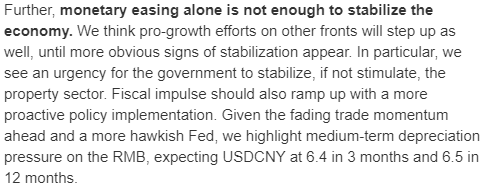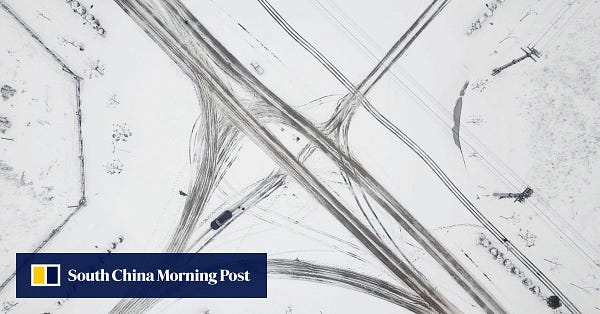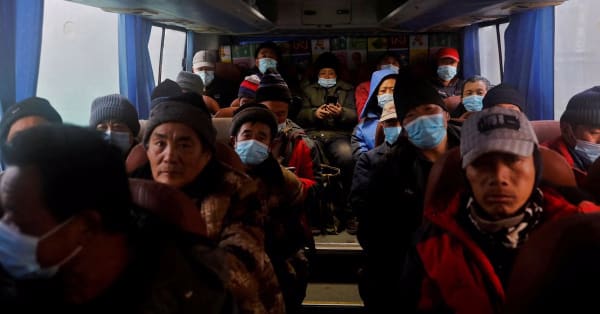Welcome to the 99th edition of Trade War.
China reports 8.1 percent growth for last year but in the fourth quarter it slid to a lackluster four percent. The economy slips into a construction recession and the central bank moves into easing mode.
The Biden administration monitors business data from China to gauge whether omicron outbreaks will disrupt global supply chains. Taiwanese identity grows in the face of Beijing’s threats. And US business people make callous comments when asked about the plight of Xinjiang’s Uyghurs.
China grows 8.1% last year
China reported 8.1 percent annual growth last year, higher than expected, but the final months of 2021 showed signs of weakness, report the South China Morning Post’ Frank Tang and Orange Wang.
Even as full year growth exceeded the official target of ‘above six percent,’ the fourth quarter slowed to four percent, below the previous three months 4.9 percent, as challenges including new pandemic outbreaks and the property market cool down hit the economy.
“China’s problems have been further complicated by a worsening demographic picture, as births dropped to 10.6 million last year from 12 million in 2020,” write Tang and Wang. “Though the mainland’s population increased in 2021 to 1.4126 billion, it grew by a paltry 0.03 per cent, or 480,000, alarming observers.”
Still, as long as China’s economic growth exceeds that of the U.S. by 1.5 percent annually (the U.S. is expected to grow by 6 percent in 2021, according to the World Bank), it will become the world’s largest economy by 2028-2030, and some twice the size of the U.S. by 2049, predicts Peking University’s National School of Development Dean Yao Yang.
China’s 2021 GDP reached 114.37 trillion yuan (US$18 trillion) accounting for 18 percent of the global economy.


China in construction recession
“It's official: China is now in a construction recession,” tweets Gavekal Dragonomics research director Andrew Batson.
“Real value-added of the construction sector has declined on a year-on-year basis for two consecutive quarters, the first time this has happened since China has had quarterly GDP data,” Batson writes.


Avoiding a collapse in credit
Even as the U.S. struggles with inflation, China’s central bank signaled that it will ease credit policy to boost growth, reported Bloomberg News.
The People’s Bank of China will “open the monetary policy tool box wider, maintain stable overall money supply and avoid a collapse in credit,” Deputy Governor Liu Guoqiang said Tuesday in Beijing.
“Coming a day after the PBOC cut its policy interest rate for the first time in almost two years, the comments reinforce a clear easing bias and underscores policymakers’ determination to support growth in a year of political transition,” reported the financial news service.
As expected, the central bank took the further easing step of cutting benchmark lending rates on Thursday, reducing the one-year loan prime rate from 3.8 percent to 3.7 percent, and the five-year rate from 4.65 percent to 4.6 percent.
“The PBOC’s easing stance is in stark contrast with other major central banks like the Federal Reserve, which is forecast to hike rates to contain inflation,” reports Bloomberg. The expectation is “the central bank will continue cutting official rates while its global peers tighten policy.”


Provinces cut growth forecasts
In the face of omicron outbreaks and slowing property markets, the provinces of Zhejiang, Anhui, Sichuan, Hunan, and Chongqing have all cut their growth forecasts for this year, reports the South China Morning Post’ Frank Tang and Amanda Lee.
“That some provinces have begun revising down their growth targets underscores the difficulties ahead for the world’s No 2 economy,” write Tang and Lee.
The new targets range from 5.5 percent for Chongqing, down from 6 percent last year, to 6.5 percent for Sichuan, down from a 7 percent target last year and actual growth of 8.2 percent.
“Achieving the [national] growth target will be a lot more challenging this year, even if it is lowered to 5 percent,” Julian Evans-Pritchard, a senior China economist of Capital Economics wrote in a note.


Monitoring omicron supply chain disruptions
The Biden administration is monitoring business data from China to determine whether omicron outbreaks could disrupt U.S. supply chains, reports Bloomberg News’ Jenny Leonard, citing a U.S. official.
“Information is shared with companies in the supply chain to alert them of potential delays, the official said,” reports Leonard. “The data collection begins with the U.S. embassy in Beijing and the State Department’s regional bureaus, which mine contacts around the country to gain a better view of the virus’s spread.
“The data capture port and air-freight activity as well as information that private-sector companies provide to the government about their own facilities or suppliers in China. It informs forecasting systems used by White House economists to measure the impact on the U.S. economy,” reports the financial news service.

China only buys 10% of trade deal commitments?
China is even further from having met Phase One trade deal buying commitments of U.S. energy, agriculture, and manufacturing goods then has been usually reported, writes Economist reporter Simon Rabinovitch.
“Many reports say 60%, which is pretty bad. But another way of looking at it, which I think is closer to the spirit of the deal, is even worse: try 10%,” he writes in a tweet thread.
“Who's to blame? Some might say that Biden has been soft or China slippery. But the real culprit is much simpler: wildly unrealistic targets from the outset.”

Taiwanese identity grows amidst Beijing threats
Taiwanese increasingly see themselves as having an identity distinct from China, report the New York Times’ Amy Qin and Amy Chang Chien.
While over 90 percent of Taiwan’s people have ancestors who originally came from China, “they are embracing an identity that is distinct from that of their Communist-ruled neighbor,” reports the Times. “Beijing’s strident authoritarianism — and its claim over Taiwan — has only solidified the island’s identity.”
More than 60 percent of Taiwan’s 23 million people identify as Taiwanese, three times more than in 1992, according to Taipei’s National Chengchi University Election Study Center. Meanwhile just two percent called themselves Chinese, dropping from 25 percent thirty years ago.
China’s leaders view this trend as a threat to eventual unification and are responding with their own threats: “Those who forget their heritage, betray their motherland, and seek to split the country will come to no good end,” Xi Jinping warned in October of last year.
The end to China’s population growth
China’s birth rate has fallen for a fifth year, exacerbating a demographic crisis that will hurt the economy and could affect political stability, report the New York Times’ Steven Lee Myers and Alexandra Stevenson.
Births in 2021 fell to 10.6 million, down from 12 million the year before; that figure is even fewer than the number in 1961, during the famine set off by the Great Leap Forward.
“The number of people who died in 2021 — 10.1 million — approached the number of those born,” reports the Times. “The year 2021 will go down in Chinese history as the year that China last saw population growth in its long history,” said University of California, Irvine sociologist Wang Feng.


US business and Xinjiang
Over the last week two U.S. business figures have made strikingly callous comments on Xinjiang and the dire human rights abuses facing Uyghur Muslims.
“Nobody cares about what is happening to the Uyghurs,” said Chamath Palihapitiya, the billionaire co-owner of the Golden State Warriors and founder of Social Capital, in a podcast. “Of all the things that I care about? Yes, it is below my line.”

‘I divorce myself… I can’t change that’
When asked about the human rights abuses in Xinjiang in a BBC interview, Craig Smith, the boss of the China subsidiary of snowboarding company Burton, defended his company doing business there.
“I divorce myself. What I mean by that - is I can’t change that,” said Smith, referring to the abuses of Uyghurs. Instead, he says his role in Xinjiang is “sharing the fun of snowboarding,” by, for example, “high-fiving each other after a fun powder run.”

Notable/In Depth
A year into his term, U.S. president Joe Biden still hasn’t come up with a clear China strategy, writes Bloomberg News’ Jenny Leonard
“I’m not sure Biden has clearly articulated a China policy yet,” says Virginia Senator Mark Warner. “I would argue they’re working towards building these alliances of the willing that Trump was so unwilling to do, and I’d give them a grade of trying, but incomplete, at this point.”

Beijing has pledged to further clamp down on its technology sector while attacking corruption linked to the “disorderly” expansion of capital, reports Bloomberg News.
“Efforts will be made to investigate and punish corrupt behaviors behind the disorderly expansion of capital and platform monopolies, and cut off the link between power and capital,” the Central Commission for Discipline Inspection said in a communique. “Show no mercy to those who engage in political gangs, small circles, and interest groups within the party, and strictly educate, manage and supervise young cadres.”

The Chinese city of Bengbu, Anhui is facing a ‘win or die’ situation after a year when its economy did not grow, reports the South China Morning Post’ Amanda Lee.
While “Bengbu city has made new achievements in promoting innovation and development,” the challenge “of a stalling economy, development dislocation, and structural imbalance, has become prominent, and it has reached the critical moment of to win or die,” said Anhui’s provincial party secretary Zheng Shanjie.


Shanghai’s official trade union has submitted a proposal (Chinese) calling for giving platform workers a voice in how Internet companies use algorithms in their businesses.
“The proposal specifically addresses algorithms that determine delivery schedules for gig workers — like restaurant delivery, freight drivers, couriers, and ride-hailing drivers,” tweets Trivium China tech partner Kendra Schaefer.


Chinese social media has been gripped by the story of the hard life of a former fisherman surnamed Yue, who came to Beijing looking for his missing son, worked a series of low-paid, exhausting jobs, and got Covid. Xinhua News’ Zichen Wang has translated the original account into English for his newsletter Pekingnology.


“Social media users declared Yue "The hardest working man found in a COVID-19 investigation" - a hashtag that amassed over 60 million views on Twitter-like Weibo, drawing attention to the deep inequality in China,” reports Reuters.
“Some social media users drew attention to the disparity between Yue's movements and another recent COVID-19 case in Beijing who went to a ski resort and a jewelry store before testing positive for the virus.”


Montana morning
Blue sky tries to break through some heavy gray clouds, on a recent morning.





